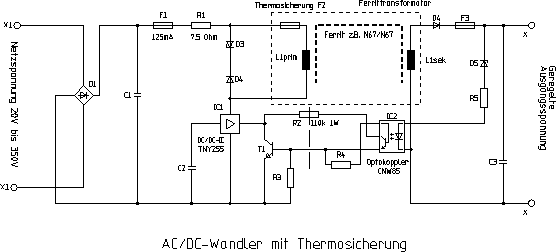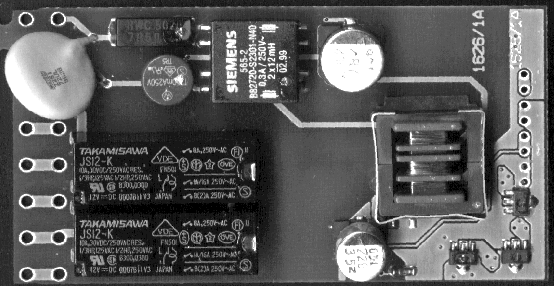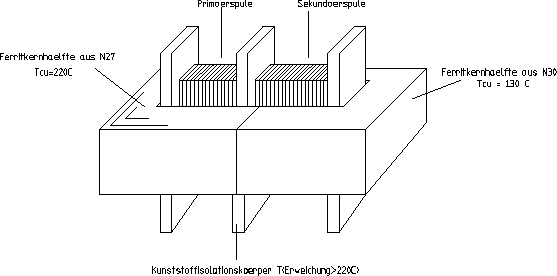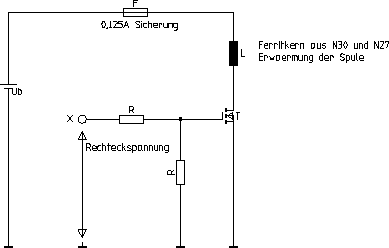Next: More measures designed to Up: How Pierre Curie protects Previous: How Pierre Curie protects
![]()
![]()
![]()
Next: More
measures designed to
Up: How
Pierre Curie protects
Previous: How
Pierre Curie protects
At the Curie temperature Tcu which is specified for the corresponding materials in the manufacturers' data sheets, the relative permeability µr(B,T) of a magnetic material (ferrite) will decrease to nearly 1, i.e. the ferrite will no longer contribute to the bundling of the magnetic flux. Above the Curie temperature, the following formula applies for the permeability
![]()
the magnetic resistance increases over the length of the ferrite. The drop in relative permeability µr(B,T) occurs abruptly over several degrees (Fig. 2).

Fig. 2: Permeability response at rising temperature of the ferrite material at a Curie temperaturer Tcu=130°C
Above this Curie temperature, it can be said that the ferrite does not exist any longer in the magnetical sense.
The consequence is that
a) the inductance L of the windings significantly decreases, thus offering a much smaller resistance to the alternating current, and
b) the transmission characteristic between the primary side and the secondary side is affected in such a way that a power transmission from the primary side to the secondary side becomes much more difficult.
If a part of the magnetic circuit now consists of a material having a much lower Curie temperature Tcu than the softening temperature Tsoft of the insulation carrier (coil former), this Curie temperature however is higher than the maximum operating temperature Ta (Ta<Tcu<Tsoft)), in case of a failure the thermal losses inside the ferrite will result in a sudden drop of inductance from a certain temperature Tcu on, which is smaller than the softening temperature of the coil former. Even in input circuits oscillating in an uncontrolled way of an AC/DC or DC/DC converter the primary current will increase quickly as a result of the decreasing inductance L1prim, and blow a fuse connected into the primary circuit and thus reliably interrupt the power supply.
The AC/DC or DC/DC converter is actively operated by a flyback converter IC (IC1) serving as the converter's control and clock (Fig. 4). In proper operation, currents and dissipation power are monitored and in this situation no threat to the insulation path is expected.

Fig. 3: A transformer conventionally protected by a thermo fuse.

Fig. 4: Circuit diagram of an intrinsically safe explosion-proof (Exi) wide range voltage supply with the protective measures for the insulation barrier at the transformer (ferrite Tcu=130°/220°C) and fuse F1 with a fuse resistance (R1) and at the optocoupler (R2).

Fig. 5: PCB top side of an intrinsically safe explosion-proof (Exi) wide range voltage supply with EF16 transformer. According to current regulations, a creeping distance of 3.3 mm beneath lacquer must be provided between the mains circuit and the output circuit, and a 1-mm thick solid plastic insulation must be provided between the transformer chambers. Here, the relays do not have any function in connection with the power supply
In dangerous situations it cannot be assumed that the flyback converter IC will still take on any control function. Instead, a failure-case analysis will be performed based on the following assumptions.
a) Let us assume that a failure appears in IC1 (short circuit caused by a breakdown of drain and source of the IC's output MOSFET), but the IC no longer oscillates. The fuse F1 (125 mA) will blow as soon as direct current flows through the low-impedance winding L1prim with w number of turns.
At a mains voltage of 50Hz/60Hz, the resistance of the coil L1prim is approximately the ohmic resistance of the copper wire depending on the wire diameter and length. For DC/DC converters with high oscillator frequencies the ohmic resistance is relatively small (usually only a few ohms).
The maximum dissipation power at the coil L1prim (3 Ohms) results in e.g. (including the 1.7X safety current and a safety factor of 1.5)
![]()
At this dissipation power of 200 mW no risk of insulation destruction is to be expected.
b) In principle, the possibility cannot be ruled out that the flyback converter IC oscillates in an uncontrolled way with a high amplitude (up to 350 V) but no longer fulfills its control function due to failure reasons and that the fuse F1 has not yet blown and thus a high dissipation power (development of heat inside the ferrite) may be generated at the transformer. In order to prevent the insulation barrier from melting, we use the physical fact described above:
The coil former consists of a plastic material having a maximum usage temperature of 220°C for several hours (Fig. 6).

Bild 6: Fig. 6: Schematic design of an EF16 core consisting of a ferrite half having aTcu=130°C and another half having a Tcu=220°C . The plastic carrier is made of a material with a softening temperature of more than 220°C. Primary and secondary coil are housed in separate chambers in order to ensure creeping distances of 3.3 mm beneath lacquer and a 1-mm thick insulation.
The magnetic transmission medium in the converter consists of one core half EF16 made of the material having a permeability µr=4300 and a Curie temperature Tcu=130°C and a second core half made of the material having a permeability µr=2000 with an air gap of 0.06 mm and a Curie temperatureTcu=220°C. In this state the core has a specified magnetic resistance of
![]()
for the magnetic flux
![]()
The
uncontrolled oscillation (failure case) of the flyback converter IC1
when fuse F1 has not yet blown can generate heat in the transformer.
If the core temperature exceeds 130°C, above the first Curie
temperature Tcu=130°C this core half will have a very high
magnetic resistance ( µr=4300 approaches nearly 1, i.e. = air)
for the magnetic flux
![]() ,
and the inductance decreases near to the value without the magnetic
core.
,
and the inductance decreases near to the value without the magnetic
core.
![]()

Fig. 7: Inductance behavior of a coil wrapped up on a 130°C/220°C ferrite system and warmed up there. Above the Curie temperature the inductance (mH) drops suddenly and extremely.
Tests and measurements have shown that the inductance of a coil equipped with a core half having a Tcu=130°C drops dramatically if it is warmed up above the Curie temperature (Fig. 7). For that purpose two reverse-wound heating coils (Lheat1 and Lheat2) and a copper coil (Ltest) have been attached to the coil former (Fig. 8). Reverse-wound heating coils are used in order to prevent a DC premagnetization of the core by the heating current.

Fig. 8: Test setup of a heated Tcu=130°C/220°C transformer with one measuring coil and two reverse-wound heating coils (Lheiz1 and Lheiz2). The temperature at the ferrite is measured by a thermocouple, the inductance of the test coil (Ltest) is monitored by an inductance meter via temperature.

Fig. 9: shows the basic circuit configuration in a typical flyback design.
Test setup of a heated Tcu=130°C/220°C transformer with high-frequency stimulation. A high-frequency signal is applied to the gate of the MOSFET T. The temperature at the ferrite is rising because the power dissipation increases. The ferrite core is warmed up above the Curie temperature, the inductance of the coil L drops dramatically. The fuse F (125 mA) blows.
The primary current rises high above the operating current for which fuse F1 inside the input circuit was designed. The fuse blows before the coil former softens at a temperature of above 220°C (there may be a thermal balance between 130°C to 160°C, but its temperature is much lower than the softening temperature of the coil former of 220°C).
The coil former does not reach its softening temperature and the insulation path remains intact.
A
side-effect is that the magnetic flux
![]() decreases extremely by the enormous increase of the magnetic
reluctance (2-3 decades) despite of the rising magnetomotive force
m.m.f., so that the induced voltage on the secondary side
decreases extremely by the enormous increase of the magnetic
reluctance (2-3 decades) despite of the rising magnetomotive force
m.m.f., so that the induced voltage on the secondary side
![]()
drops and therefore the power is also limited at this point.
This ensures that the insulation body of the transformer is protected against the insulation barrier melting in case of direct current or near direct current as well as during oscillation.
This protection principle is a recognized security technology and part of a patent pending. You can find more detailed information such as theoretical calculations of magnetic circuits similar to electric circuits and descritions of a PSPICE simulation model of the EF16 core in comprehensive application documentation provided by TURCK or in german at my homepage.
![]()
![]()
![]()
Next: More
measures designed to
Up: How
Pierre Curie protects
Previous: How
Pierre Curie protects